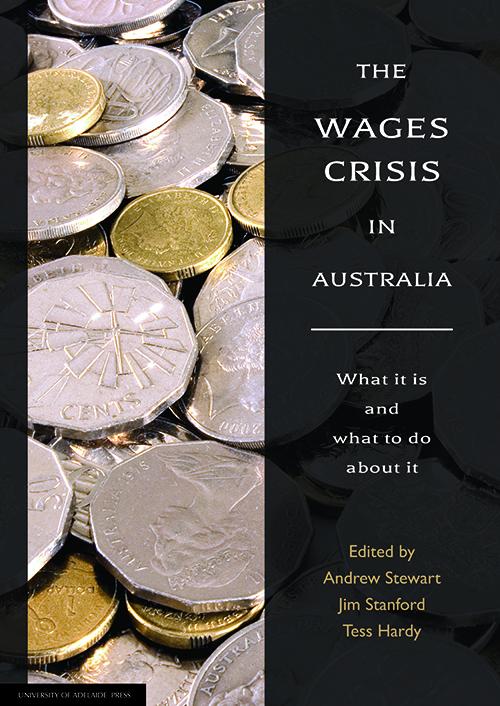The Wages Crisis in Australia

What it is and what to do about it
edited by Andrew Stewart, Jim Stanford and Tess Hardy
FREE | 2018 | Ebook (PDF) | 978-1-925261-83-7 | 360 pp
DOI: https://doi.org/10.20851/wages-crisis
The print edition is available from Federation Press. Please direct print edition inquiries to Federation Press info@federationpress.com.au
-
Chapter details
I. THE PROBLEM
1. Australia, we have a problem
Jim Stanford, Tess Hardy and Andrew Stewart
DOI: https://doi.org/10.20851/wages-crisis-012. Charting wage stagnation in Australia
Jim Stanford
DOI: https://doi.org/10.20851/wages-crisis-023. Global perspectives on wage stagnation
Stephen Kinsella and John Howe
DOI: https://doi.org/10.20851/wages-crisis-034. What's causing the wages slowdown?
Tess Hardy and Andrew Stewart
DOI: https://doi.org/10.20851/wages-crisis-04II. WAGE SETTING MECHANISMS AND INSTITUTIONS
5. Minimum wages
Tim Lyons
DOI: https://doi.org/10.20851/wages-crisis-056. Gender pay equity
Sara Charlesworth and Meg Smith
DOI: https://doi.org/10.20851/wages-crisis-067. Collective bargaining power
David Peetz
DOI: https://doi.org/10.20851/wages-crisis-078. Public sector austerity and its spill-over effects
Troy Henderson
DOI: https://doi.org/10.20851/wages-crisis-089. Contracting out community services, marketisation and wages
Fiona Macdonald and Michael Pegg
DOI: https://doi.org/10.20851/wages-crisis-0910. Executive remuneration in listed companies and wage setting
Kym Sheehan
DOI: https://doi.org/10.20851/wages-crisis-10III. BUSINESS STRUCTURES AND VULNERABLE WORKERS
11. Fractured word
Josh Bornstein
DOI: https://doi.org/10.20851/wages-crisis-1112. Wage theft and young workers
Keelia Fitzpatrick
DOI: https://doi.org/10.20851/wages-crisis-1213. Temporary migrant workers, underpayment and predatory business models
Iain Campbell
DOI: https://doi.org/10.20851/wages-crisis-1314. Is there a wages crisis facing skilled temporary migrants?
Joanna Howe
DOI: https://doi.org/10.20851/wages-crisis-14IV. STAKEHOLDER PERSPECTIVES ON CAUSES, CONSEQUENCES, AND SOLUTIONS
15. A business perspective
Saul Eslake
DOI: https://doi.org/10.20851/wages-crisis-1516. A union perspective on the wages crisis and how to solve it
Damian Kyloh
DOI: https://doi.org/10.20851/wages-crisis-1617. A community perspective: The human and social costs of wage stagnation
John Falzon
DOI: https://doi.org/10.20851/wages-crisis-1718. Young Australians and the disrupted economy
Annette Cairnduff, Kelly Fawcett and Nina Roxburgh
DOI: https://doi.org/10.20851/wages-crisis-1819. An investor perspective
Craig Shepherd and Penny Heard
DOI: https://doi.org/10.20851/wages-crisis-19V. FINDING SOLUTIONS
20. Conclusion: Wages and inclusive growth
Andrew Stewart, Jim Stanford and Tess Hardy
DOI: https://doi.org/10.20851/wages-crisis-20APPENDIX
An overview of labour regulation in Australia
Andrew Stewart
DOI: https://doi.org/10.20851/wages-crisis-a
The persistence of weak wages growth in Australia, at a time when the state of the economy might suggest much better outcomes for workers, has baffled policy makers.
Andrew Stewart, Jim Stanford and Tess Hardy have drawn together expert analysts from business, universities, think tanks, community organisations and trade unions to answer four pressing questions: What is the wages crisis? Why is it happening? Why does it matter? And what should we do about it?
Written in non-technical terms for a general audience, the essays in this book offer many insights into one of Australia’s most pressing economic and social issues. They highlight the key point that wage stagnation is a problem with multiple causes and dimensions. It will not fix itself, but will need decisive policy action. In their conclusion, the editors set out their own views of what that might be.
Review
'As the editors – Jim Stanford, Tess Hardy and Andrew Stewart – note, once the Reserve Bank of Australia (RBA) Governor, Dr Philip Lowe, encourages workers to demand higher wages, we do indeed have a problem.'
In his review, George Lafferty from Western Sydney University describes this timely book as one that 'opens up a range of complex, interconnected issues relevant to Australia’s wages crisis' by drawing 'on a diverse range of expert and stakeholder contributions'.
Read the full review, published in the Economic and Labour Relations Review.
